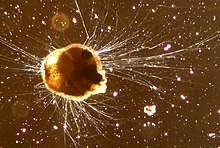The Rhizaria are a species-rich supergroup of mostly unicellular[1] eukaryotes.[2]Except for the Chlorarachniophytes and three species in the genus Paulinella in the phylum Cercozoa, they are all non-photosynthethic, but many foraminifera and radiolaria have a symbiotic relationship with unicellular algae.[3] A multicellular form, Guttulinopsis vulgaris, a cellular slime mold, has also been described.[4] This supergroup was proposed by Cavalier-Smith in 2002. Being described mainly from rDNA sequences, they vary considerably in form, having no clear morphological distinctive characters (synapomorphies), but for the most part they are amoeboids with filose, reticulose, or microtubule-supported pseudopods. The Rhizaria’s pseudopodial mineral skeleton network, which is made up of opal (SiO₂), celestite (SrSO₄), or calcite (CaCO₃), is what differentiates it from the amoebae. It can attain sizes of more than a centimeter with some species being able to form cylindrical colonies approximately 1 cm in diameter and greater than 1 m in length. They feed by capturing and engulfing prey within the extensions of their pseudopodial skeletons, and some even become homes for algae, which aid in boosting the total primary production of the ocean.[5]
| Rhizaria Temporal range: Neoproterozoic - Recent | |
|---|---|
 | |
| Ammonia tepida (Foraminifera) | |
| Scientific classification | |
| Domain: | Eukaryota |
| (unranked): | Diaphoretickes |
| Clade: | TSAR |
| Clade: | SAR |
| (unranked): | Rhizaria Cavalier-Smith, 2002 |
| Phyla | |
https://en.wikipedia.org/wiki/Rhizaria
No comments:
Post a Comment